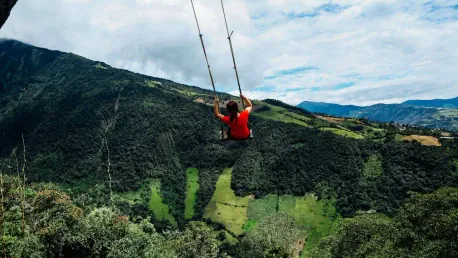Nestled within the Choco-Andean cloud forest, Mashpi Lodge stands as a beacon of sustainable tourism and conservation. Located a mere three-hour drive from Quito, Ecuador’s capital, this luxurious lodge exemplifies the harmonious blend of ecological responsibility and opulent accommodations. The brainchild of Roque Sevilla, an economist, businessman, and former mayor of Quito, Mashpi Lodge’s journey began in 2001 with the acquisition of 600 hectares from a failing logging company. Recognizing the region’s ecological significance, Sevilla transitioned local loggers and poachers into gamekeepers and funded biologists to study the reserve’s biodiversity. The minimalist glass-and-steel structure of the lodge was designed to minimize environmental impact while providing luxury to its guests. The lodge’s operations support rangers, create local employment opportunities, and introduce visitors to the biodiverse wilderness.
The Biodiversity of Mashpi Reserve
A Haven for Bird Species
The Mashpi Reserve is renowned for its remarkable biodiversity, particularly its avian population. Gabriel Araque, one of the lodge’s guides, notes that the region is home to 400 bird species, a stark contrast to the 750 bird species found across North America. This incredible diversity is a key attraction for visitors and underscores the ecological richness of the area. Unique species discoveries in the last decade, including various insects, frogs, orchids, and trees like the ‘little spoon’ magnolia, highlight the reserve’s significance.
Birding enthusiasts specifically flock to Mashpi for its wealth of bird species, some found nowhere else on earth. Each visit to the reserve presents the chance to observe rare and unique sightings, making every experience distinct even for seasoned birdwatchers. The broad array of species provides an excellent opportunity for researchers and ornithologists to study avian behavior, migratory patterns, and interactions within such a dense ecological milieu. At Mashpi, birdwatching becomes not just a leisure activity but an educational journey into one of the world’s most biodiverse regions.
Exploring the Canopy
Visitors to Mashpi Lodge can explore the reserve via the Dragonfly, an open-topped gondola that traverses a 4 km loop through the forest canopy, sometimes soaring 200 meters above the ground. This unique vantage point allows guests to experience the forest’s layered habitat, with different flora such as epiphytes and orchids capturing moisture from the clouds. The diverse topography and microclimates of the forest contribute to its rich biodiversity, making each visit a unique experience.
The Dragonfly offers a bird’s-eye view of the canopy, showcasing the symbiotic relationships among the forest’s inhabitants. Araque and other guides provide insightful narratives about the vital roles of various plant and animal species, drawing attention to how each layer of the canopy contributes to the overall health of the ecosystem. This perspective not only enhances visitor appreciation but also deepens understanding of conservation efforts. By illustrating the intricate interdependencies within the forest, Mashpi fosters a greater commitment to preserving such delicate ecosystems among its guests.
Daily Activities and Sensory Experiences
Morning Birdwatching
Every day at Mashpi Lodge begins with birdwatching from a panoramic terrace as mist ascends the ridgeline. The diverse fauna includes animals like the tayra, a badger-like creature, and a multitude of bird species. This early morning activity sets the tone for a day of exploration and discovery in the cloud forest.
Early morning birdwatching sessions are more than just a visual treat; they are an immersive experience where visitors can listen to the symphony of bird calls and witness the forest awakening. These observations, often accompanied by knowledgeable guides, provide deeper insights into the behaviors and migratory patterns of the resident bird species. The activity fosters a sense of connection with nature that many guests carry with them long after they leave Mashpi, promoting a lifelong interest in conservation and wildlife protection.
The Hummingbird Garden
As the day progresses, the forest’s sensory experiences shift. Bird songs give way to cicada chirrups, and floral scents are replaced by earthy ones. One of the highlights is the Hummingbird Garden, located on one of the higher ridges. Here, visitors can interact with hummingbirds attracted to the specifically planted vegetation, demonstrating the harmonious relationship between human intervention and natural wildlife behaviors.
The Hummingbird Garden exemplifies the lodge’s commitment to enhancing natural habitats while providing enriching experiences for visitors. The garden is meticulously designed to attract a variety of hummingbird species, offering close-up interactions that highlight the birds’ dazzling colors and rapid movements. This interactive setting educates guests on the importance of habitat conservation and the delicate balance needed to sustain these vibrant creatures. It also underscores the potential for human efforts to positively impact wildlife, illustrating a practical application of conservation principles in everyday settings.
Commitment to Scientific Research
Tracking Pumas
Mashpi Lodge prioritizes scientific research, employing full-time researchers like Chiara Correa. She tracks five adult pumas whose territories overlap with the reserve and advocates for establishing wildlife corridors that allow safe passage through farmlands to other forests. This integration of research underscores Mashpi’s commitment to long-term sustainability and wildlife conservation.
The tracking of these elusive predators offers valuable data on their movements, hunting patterns, and interactions with other wildlife. This information is crucial for developing effective conservation strategies that support coexistence between humans and large carnivores. The research conducted by Correa and her team not only advances scientific understanding but also informs policy decisions and land management practices. By prioritizing such studies, Mashpi contributes to broader efforts to protect vulnerable species, showcasing the tangible benefits of integrating science with sustainable tourism.
Biodiversity Studies
The lodge’s commitment to scientific research extends beyond tracking large mammals. Biologists funded by Sevilla have conducted extensive studies on the reserve’s biodiversity, uncovering new species and gaining a deeper understanding of the ecosystem. These efforts are crucial for informing conservation strategies and ensuring the protection of the region’s unique flora and fauna.
Discoveries of previously unknown species underscore the forest’s untapped potential and highlight the ongoing need for exploration and study. Each new finding adds to the scientific community’s knowledge, underpinning conservation initiatives with robust data. The biologists’ work often involves cataloging species diversity, studying genetic variations, and assessing the impacts of environmental changes. Such comprehensive research efforts fortify Mashpi’s role as a guardian of biodiversity, emphasizing the necessity of continuous investigation to safeguard these complex and interdependent ecosystems.
Community Engagement and Local Involvement
Employment and Education
Engagement with the local community is a cornerstone of Mashpi Lodge’s operation. The lodge hosts school visits and employs many guides from local communities. This involvement not only provides employment opportunities but also fosters a sense of ownership and pride in the conservation efforts.
By integrating local knowledge and expertise, Mashpi ensures that conservation efforts are both culturally sensitive and economically beneficial. Educational programs aim to instill a conservation ethic in younger generations, ensuring that the community remains invested in preserving their natural heritage. These initiatives create a symbiotic relationship where locals become stewards of the environment while benefiting from sustainable income sources. This approach not only enhances conservation outcomes but also strengthens the social fabric of surrounding communities, illustrating an inclusive model of sustainable development.
Expanding the Model
The involvement of locals is expanding, with some, like Gabriel and his father, aspiring to develop their own lodges on family lands. Sevilla welcomes this competition, viewing it as a scalable model for conservation. Mashpi Lodge aims to protect not just its 3,000-hectare reserve, but an ambitious 500,000 hectares of the Choco-Andean rainforest over the next decade. This goal necessitates collaboration with other landowners who may also develop eco-friendly lodges, reinforcing the model of conservation through tourism.
This collaborative vision promotes a network of conservation-focused lodges that collectively enhance the region’s ecological health. By encouraging other landowners to adopt sustainable tourism models, Mashpi aims to create a unified front against deforestation and habitat loss. The lodge’s influence extends beyond its immediate operations, fostering a broader movement that combines economic incentives with ecological stewardship. This scalable model has the potential to transform regional conservation efforts, demonstrating how local entrepreneurship can be aligned with global environmental goals.
Broader Conservation Efforts
The Futuro Group’s Initiatives
Beyond tourism, Sevilla’s Futuro Group, encompassing insurance and logistics businesses, dedicates 3% of its gross profits to a foundation promoting sustainable farming and reforestation. This foundation has also spearheaded movements to halt oil extraction in the Amazon and gold mining in the Choco-Andes, with significant success reflected in a national referendum to stop both activities in Ecuador.
These initiatives showcase a holistic approach to sustainability, addressing broader environmental issues that impact not only Mashpi’s reserve but also the wider Ecuadorian landscape. By leveraging business profits for conservation, Sevilla demonstrates that corporate social responsibility can drive substantial environmental change. The foundation’s work in sustainable farming helps local communities adopt ecologically sound practices, reducing pressure on natural resources. Meanwhile, national campaigns against resource extraction highlight the importance of protecting critical habitats from industrial exploitation.
A Vision for the Future
The Mashpi Reserve is celebrated for its exceptional biodiversity, particularly its bird population. Gabriel Araque, a guide at the lodge, points out that the region hosts 400 bird species, a stunning number compared to the 750 species found across North America. This remarkable diversity draws visitors and highlights the area’s ecological wealth. In recent years, unique species discoveries have been made, including various insects, frogs, orchids, and trees like the ‘little spoon’ magnolia, emphasizing the reserve’s importance.
Birding enthusiasts are especially drawn to Mashpi due to its abundant bird species, some of which are exclusive to the reserve. Each visit offers the opportunity to observe rare and unique species, providing a fresh experience even for seasoned birdwatchers. The extensive array of species offers researchers and ornithologists a unique chance to study avian behavior, migratory patterns, and interactions within such a dense ecological setting. At Mashpi, birdwatching is more than a pastime—it’s an educational adventure into one of the planet’s richest biodiversity hotspots.









